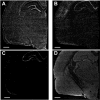Advanced imaging of multiple mRNAs in brain tissue using a custom hyperspectral imager and multivariate curve resolution
- PMID: 17049619
- PMCID: PMC1815393
- DOI: 10.1016/j.jneumeth.2006.08.018
Advanced imaging of multiple mRNAs in brain tissue using a custom hyperspectral imager and multivariate curve resolution
Abstract
Simultaneous imaging of multiple cellular components is of tremendous importance in the study of complex biological systems, but the inability to use probes with similar emission spectra and the time consuming nature of collecting images on a confocal microscope are prohibitive. Hyperspectral imaging technology, originally developed for remote sensing applications, has been adapted to measure multiple genes in complex biological tissues. A spectral imaging microscope was used to acquire overlapping fluorescence emissions from specific mRNAs in brain tissue by scanning the samples using a single fluorescence excitation wavelength. The underlying component spectra obtained from the samples are then separated into their respective spectral signatures using multivariate analyses, enabling the simultaneous quantitative measurement of multiple genes either at regional or cellular levels.
Figures



References
-
- Dickinson ME, Bearman G, Tille S, Lansford R, Fraser SE. Multi-spectral imaging and linear unmixing add a whole new dimension to laser scanning fluorescence microscopy. Biotechniques. 2001;31:1272–8. - PubMed
-
- Guzowski JF, McNaughton BL, Barnes CA, Worley PF. Environment-specific expression of the immediate-early gene Arc in hippocampal neuronal ensembles. Nat. Neurosci. 1999;2:1120–4. - PubMed
-
- Haaland DM, Timlin JA, Sinclair MB, Van Benthem MH, Martinex MJ, Aragon AD, Werner-Washburne M. Multivariate curve resolution for hyperspectral image anlaysis: applications to microarray technology. Proc SPIE. 2003;4959:55–66.
-
- Huebschman ML, Schultz RA, Garner HR. Characteristics and capabilities of the hyperspectral imaging microscope. IEEE Eng. Med. Biol. Mag. 2002;21:104–17. - PubMed
Publication types
MeSH terms
Substances
Grants and funding
LinkOut - more resources
Full Text Sources
Other Literature Sources

